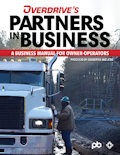
The research arm of the Owner-Operator Independent Drivers Association, the OOIDA Foundation, traces the roots of high driver turnover in U.S. trucking -- particularly within the long-haul truckload sector -- to deregulation in the 1980s. It brought in thousands of new motor carriers, and increased competition within the market.
“This competitive landscape effectively eliminated companies’ ability to raise pay significantly without losing business, embedding high turnover as a standard business strategy,” OOIDA noted in its one-page summary of the new research around turnover, providing additional data it hopes will refute a long-held stance within trucking that a truck driver shortage exists.
The research offers recommations for several areas with potential for improvement, including but not limited to:
- Policy. Subsidies for driver training treat symptoms, not causes, of turnover.
- Regulation. Motor carriers' overtime pay exemption needs to be reconsidered.
- Industry practice. "Churn-and-burn" model contains hidden costs; lease-purchase contracting practice should reward experience, efficiency.
Titled “The Churn: A Brief Look at the Roots of High Driver Turnover in U.S. Trucking,” the full research report takes on what OOIDA considers a dangerous, false narrative of a driver shortage that undercuts pay and hinders healthy industry growth.
“People have touched on this issue multiple times in the past,” said Charles Sperry, a research analyst with the OOIDA Foundation. The goal with this research, however, was to give “a good overview of the subject more broadly. We’ve talked about specific issues, but we wanted to have something that really touched on everything all in one place; something that you could present to somebody who is new to the issue and say, ‘All right, here we go from point A to point B, and let’s just touch on everything and get you educated on the subject all at once.'”

As has been argued by OOIDA and others about the driver shortage narrative in past, a typical labor shortage would result in higher wages and improved conditions to attract more talent. In trucking, however, “these normal market corrections fail to materialize, primarily due to deeply embedded structural and economic factors,” the research noted.
[Related: Trucking's driver shortage assertions 'spurious': New compensation report on safety, retention]
Markedly increased competition among carriers post-deregulation "effectively eliminated companies’ ability to raise pay significantly without losing business, embedding high turnover as a standard business strategy,” OOIDA noted in its one-pager summary of the research. “In today's highly fragmented truckload sector, minimal differentiation among employers keeps drivers cycling between similar low-quality jobs, or leaving the industry entirely rather than seeing substantial improvements in pay or conditions.”
Among other issues that continue to cause high turnover identified in the report is that long-haul truckers are typically paid by the mile, yet too often loading, unloading and other situations see such drivers go unpaid for their time.
Trucking’s overtime exemption within the Fair Labor Standards Act exacerbates the problem, “allowing companies to demand extensive hours without overtime pay,” the report said. “Consequently, drivers often work up to 70-hour weeks while experiencing effective hourly wages significantly lower than comparable occupations. This misaligned incentive structure externalizes the industry's inefficiencies onto drivers, fueling dissatisfaction and turnover.”
[Related: Trucker overtime pay legislation revived]
The OOIDA Foundation’s Sperry also highlighted that the research found there are approximately three new Class A CDL holders for every long-haul trucking job. There are approximately 400,000 new Class A CDLs issued each year -- typically valid for five years each -- implying that at any given moment, there are between 2 million and 2.5 million people with recently-issued CDLs. By contrast, according to the U.S. Bureau of Labor Statistics, the American economy supports roughly 800,000 to 900,000 heavy-duty, long-haul trucking jobs at any given time.
“The implication is stark: for every available trucking position, there are approximately three recent CDL holders theoretically qualified to fill it,” the research noted.
“We're not even talking about people that have had their CDLs for years,” Sperry added. “We're just talking about newbies, just new guys that have just gotten their CDL. This is their first time. There's three of those for every single available job.”
[Related: 'Labor dumping' and trucking: Are foreign CDL drivers bringing down rates?]
And while small fleets tend to have better driver retention rates than large fleets, solving the driver turnover problem at bigger fleets could have downstream impacts, according to the research. In the current trucking environment, “mega-carriers produce a surplus of trained drivers” who often end up leaving those companies, and small fleets hire some of those more experienced drivers.
Should the driver retention problem be solved, “it would actually starve smaller fleets of their talent pipeline,” the OOIDA Foundation wrote. “This perversely means even carriers that treat drivers better are indirectly reliant on the churn at the bottom end of the industry. It’s a bizarre ecosystem where churn at one level feeds the next. All of this underscores that the turnover problem is systemic, not just a matter of one or two bad actors.”
[Related: Small fleet expansion requires investment in people, systems, self-education]
Plenty churn to go around -- among owner-operators, too
It’s no secret that when things are going well in trucking, more drivers leave the employee ranks and pursue an owner-operator career with prospects of making more money on their own. When the market faces a downturn, however, many of those newer owner-operators struggle or fail.
“In other words, the owner-operator segment experiences a similar churn [to fleets], but driven by market cycles: a boom brings a wave of entrants, a bust then forces a shakeout,” the report added. Over a longer period of time, only a few independent owner-operators manage to survive.
This cycle, OOIDA Foundation said, “demonstrates another structural issue: the ease of entry into trucking (both as a driver and as a small carrier) means supply can overshoot demand quickly. With so many willing entrants during good times, the market never stays tight enough for long enough to permanently elevate wages or standards.”
Owner-operators also often end up working the fickle spot markets because large shippers tend to prefer working with larger trucking companies that can take on more capacity -- or with brokers who provide a central avenue through which to marshal it. Spot markets are far more volatile than direct contracting markets, leaving owner-ops “at the mercy of market whims and larger intermediaries, with little ability to improve their situation individually," according to the report. "If they succeed, it can be rewarding, but if they hit a downturn or run into high expenses (fuel spikes, maintenance), they can quickly go underwater.”
[Related: Tariffs' impacts on freight markets already being felt]
Carrier lease-purchase programs, which often -- but not always -- don’t result in the lessee taking possession of the truck for a variety of reasons, are also a reason for churn among owner-operators. “Many drivers who leave company jobs to become independent find the grass isn’t much greener; some thrive, but many others eventually hang up their keys, disillusioned,” according to the report. “In a properly functioning market, one might expect the independent route to serve as a corrective: if company driver jobs are underpaying, entrepreneurs should be able to earn more and draw off labor until companies must improve pay to compete.”
The report added that this happens, to an extent, but a challenge, like so many outlined above, “often thwarts the promise of independence.”
[Related: Carrier lease-purchase programs 'meaningful' for at least some owners]
The report’s analysis concludes that more needs to be done to address the distorted, systemic reasons causing such high turnover in order for market forces to move toward a more sustainable balance. Addressing all of the challenges that lead to driver churn will require changes in policy and regulations, as well as in industry practices.
“Policymakers should note that simply trying to pump more drivers into the system (through training subsidies or lower hiring standards) treats the symptom (empty trucks) but not the cause (why drivers quit),” the report noted. “Industry leaders, too, must confront the reality that a churn-and-burn model, while expedient, carries hidden costs -- in safety, in service quality, and in the public perception of the industry.”
Among changes that can be made to improve trucking’s driver turnover problem, the report calls for revisiting certain regulations like the overtime exemption, re-examining contracting practices like lease-purchases, and “encouraging business models that reward experience and efficiency rather than treat drivers as interchangeable units.”
“Only by understanding the systemic and structural reasons for churn can industry and policymakers begin to allow genuine market forces to work toward a more sustainable equilibrium -- one where driving a truck is a viable, even desirable long-term occupation, not a grueling trial with razor-thin margins that one endures only until a better opportunity comes along,” the report concluded. “Removing distortions and realigning incentives would let the price of trucking labor rise to a level that both fills seats and respects the cost of those filled seats. That, ultimately, is how a healthy market is supposed to function. For now, however, the trucking industry remains stuck in a high-turnover trap.”
[Related: Ditch the dime-a-dozen approach to drivers: Carriers need value-attitude adjustment]














